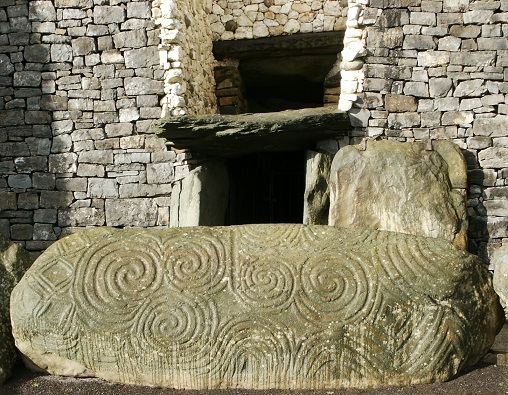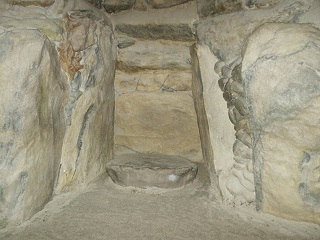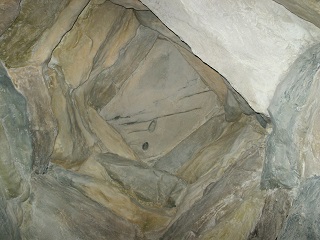
The Boyne Valley, some 20 miles northwest of Dublin in County Meath, is one of the most remarkable sites on earth, for there stands three monuments to the early settlers of Ireland, and their civilization. At first they appear to be huge mounds or hills, but closer investigation reveals them to be man-made structures. They are, in fact, more than 5000 years old and the oldest, still-standing, man-made structures on the planet. They are known as Newgrange, Knowth and Dowth and celestial manifestations occur there each December. The ancients who built the mounds called them Brú na Bóinne.
The oldest mound, Newgrange, is about 262 feet in diameter, surrounded by a border of 97 stones, with one magnificently carved stone lying in front. The front is also ringed by enormous standing boulders. Behind the front stone is the entrance to a 65-foot passage to the center of the mound and a three-cove cruciform chamber. The entire structure is formed of interlacing corbeled stones without a bit of mortar, angled in such a way that no matter how wet the covering soil becomes, seeping water is directed away and the interior remains perfectly dry. The whole mound is astronomically oriented and the passage is inclined at precisely the correct angle to allow the rays of the rising sun to shine through a small window box above the entrance and illuminate the chambers. And, the remarkable thing is that this only happens on December 21st at the winter solstice – the shortest day of the year and the point at which the power of the sun begins its annual return.
Ancient Irish manuscripts say it was built by the Tuatha De Danann, early inhabitants of Ireland who were such an advanced civilization that the Celtic settlers, who came after them, considered them possessed of magical powers and guided by the heavens. Today, it is obvious that they had an advanced knowledge of astronomy, unsurpassed in the known world at the time. To the Celts, the mounds were palaces of the otherworld, and places of special offerings. Less than a mile on either side of Newgrange are two similar mounds: Knowth and Dowth, which are also astronomically aligned with celestial events.
Knowth, the second oldest of the three, is about 275 feet in diameter and outlined by 127 massive curbstones. There are two passages in Knowth, facing east and west. The west-facing one is curved while the east-facing one is cruciform-shaped like the one in Newgrange. These passages are aligned with the rising and setting sun on the Vernal and Autumnal equinoxes. Knowth has a huge amount of stone carvings which are said to be one quarter of all of Europe’s neolithic art!
Dowth also has two passages and shares the Winter Solstice alignment with Newgrange – but at the setting sun. Beginning in November, the rays of the setting sun move along the left side of the western passage, then into the circular chamber, where, at the winter solstice, it lights up three stones. The convex center stone then reflects the sun light into a dark recess, lighting up decorated stones there. Then, until February the rays slowly recede along the right side of the passage and the sun withdraws from Dowth. For more detail, google Knowth.Com and see an incredible fly through from a laser survey.
With the coming of Christianity, the mounds fell into disrepair and were eventually overgrown. In 1142, the land on which they stood became part of the Cistercian Abbey at Mellifont. Farm fields were called granges and the mound simply became the new grange. During the Williamite confiscation of church property, the now overgrown mounds were used as a source of stones for fences. In 1699, workers gathering stones from the new grange discovered the magnificent entrance stone. Further digging revealed the passage which led to the center of the mound and the three chambers. Authorities were notified and Welsh Naturalist Edward Lhuyd came to investigate. He was credited with the discovery of a monument that had been known to the Irish for centuries. Mr. Lhuyd concluded that the great mound was a passage grave and the work of visiting Danes since nothing so sophisticated could ever be accomplished by the Irish. In 1750, General Charles Vallencey, a British Army Engineer discovered its astronomical alignment and advanced the theory that Newgrange was an astronomical observatory. He defined the standing boulders in front of the entrance as sun stones positioned to cast shadows on the carved entrance stone to indicate the seasons. He credited considerable astronomical skill to its early Irish architects, but was ridiculed by colleagues who had never even seen the mound. In spite of local tales and writings which verified this phenomenon, no archaeologist took the time to investigate it until 1969, when Michael O’Kelly entered the chamber before sunrise on the winter solstice and became the first modern archaeologist to witness that exciting event.
Subsequent studies revealed that the structure was built around 3700BC making it the oldest, still-standing, man-made building on the planet. Since the average human lifespan at that time was only 35 years and it was estimated to have taken 70 years to build, we know that they weren’t built as tombs. Finally, in 1989, the New York Times, which is ever slow to credit Irish accomplishments, noted that a British journal had announced that the astrological alignment of Newgrange appeared to be by design rather than by accident and in 1993 the megalithic monuments of the Boyne Valley were designated a World Heritage Site by UNESCO. Welcome aboard!
In spite of the amount of verified information available on this remarkable historic site, some still stand with their backs to the Boyne Valley and stare in mock amazement at Stonehenge, marveling at the antiquity of a site constructed 1,000 years later. Or they wonder at the pyramids which were only started hundreds of years after the astronomical observatories in the Boyne Valley were already functioning. It is now December, and on the 21st, the mound at Newgrange will again receive its annual message from the sun telling man that the days will now be getting longer and the long winter nights are over. How long will it be before the long night of ignorance is over as well and Irish intellectual significance is recognized.




